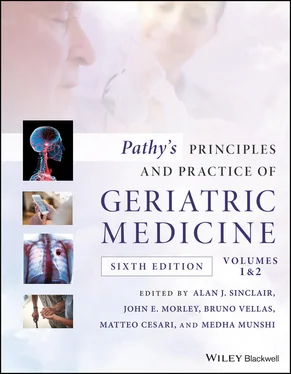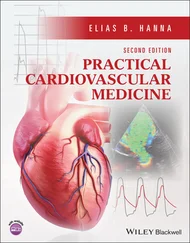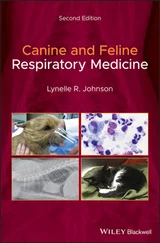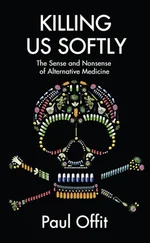Pathy's Principles and Practice of Geriatric Medicine
Здесь есть возможность читать онлайн «Pathy's Principles and Practice of Geriatric Medicine» — ознакомительный отрывок электронной книги совершенно бесплатно, а после прочтения отрывка купить полную версию. В некоторых случаях можно слушать аудио, скачать через торрент в формате fb2 и присутствует краткое содержание. Жанр: unrecognised, на английском языке. Описание произведения, (предисловие) а так же отзывы посетителей доступны на портале библиотеки ЛибКат.
- Название:Pathy's Principles and Practice of Geriatric Medicine
- Автор:
- Жанр:
- Год:неизвестен
- ISBN:нет данных
- Рейтинг книги:3 / 5. Голосов: 1
-
Избранное:Добавить в избранное
- Отзывы:
-
Ваша оценка:
- 60
- 1
- 2
- 3
- 4
- 5
Pathy's Principles and Practice of Geriatric Medicine: краткое содержание, описание и аннотация
Предлагаем к чтению аннотацию, описание, краткое содержание или предисловие (зависит от того, что написал сам автор книги «Pathy's Principles and Practice of Geriatric Medicine»). Если вы не нашли необходимую информацию о книге — напишите в комментариях, мы постараемся отыскать её.
Pathy’s Principles and Practice of Geriatric Medicine
Pathy's Principles and Practice of Geriatric Medicine — читать онлайн ознакомительный отрывок
Ниже представлен текст книги, разбитый по страницам. Система сохранения места последней прочитанной страницы, позволяет с удобством читать онлайн бесплатно книгу «Pathy's Principles and Practice of Geriatric Medicine», без необходимости каждый раз заново искать на чём Вы остановились. Поставьте закладку, и сможете в любой момент перейти на страницу, на которой закончили чтение.
Интервал:
Закладка:
Table 24.1 Coagulation tests.
| Test | Test of | Causes of abnormality |
|---|---|---|
| APTT | Intrinsic and common pathways | Factor VIII, IX, XI, XII, II, V, or X deficiency, or factor inhibitor Lupus anticoagulant Heparin |
| PT | Extrinsic and common pathways | Factor VIII, II, V, or X deficiency, or factor inhibitor Liver disease Warfarin |
| TT | Fibrinogen polymerization | A or hypo or dysfibrinogenaemia (some dysfibrinogenaemias cause thrombosis, not bleeding) Heparin |
| Fibrinogen | Fibrinogen quantity | A or hypo or dysfibrinogenaemia |
| FDP | Fibrinolysis | Disseminated intravascular coagulation Venous thrombosis |
| Platelet count | Platelet number | Thrombocytopenia or thrombocytosis |
| Bleeding time | in vitro platelet function | Thrombocytopenia Functional platelet defect or anti‐platelet drugs |
| PFA | in vitro platelet function | Aspirin, clopidogrel, or functional platelet disorder |
ITP in adults, unlike in childhood, seldom remits spontaneously. The initial treatment is with prednisolone 1 mg/kg daily or intravenous immunoglobulin 1.0 g/kg daily for two days. In patients with diabetes or renal impairment, an IvIg free from sucrose should be used. The condition is usually steroid‐responsive but frequently steroid‐dependent, and attempts to withdraw the steroids result in recurrence of thrombocytopenia. Often, the platelet count will stabilize at an acceptable level of above 50 × 10 9/l on no steroids or only a minimal dose, and in the absence of symptoms, this is often well tolerated for many years. If there is no response to steroids or an unacceptably high dose is required to maintain a satisfactory platelet count, alternative therapies include intravenous immunoglobulin, which usually raises the platelet count for around three weeks and sometimes results in a sustained remission, or the new agents that mimic thrombopoietin (TPO), the endogenous hormone that drives platelet production. Romiplostim is given by weekly injection and the dose titrated to produce a safe platelet count, while Eltrombopag is given orally daily with dose titration. Once the correct dosage is achieved, these drugs are given for 12 months; then the dose is reduced to see if remission has been achieved, which occurs in over 50% of cases. Splenectomy – which, although it does not prevent autoantibody production, does prevent premature platelet destruction by the spleen – is reserved for the most refractory cases, as it requires surgical intervention, although a laparoscopic splenectomy is far less invasive than an open splenectomy. A splenectomy successfully achieves complete remission in about 50–75% of cases progressing as far as surgery. However, splenectomy should not be undertaken lightly, as it is not without hazard, particularly in the thrombocytopenic patient. In addition to the operative risks, there is the risk of subsequent overwhelming post‐splenectomy sepsis: preoperative pneumococcal, Haemophilus influenza B , and meningococcal vaccination should be given, and postoperative penicillin prophylaxis should be considered, although compliance can be poor and the prevalence of resistant organisms is increasing. For those in whom a splenectomy is contraindicated or fails, the last resort is immunosuppressive therapy with azathioprine or cyclophosphamide, which is sometimes effective. Danazol, vitamin C, interferon, and ciclosporin have all been tried with varying efficacy, as has extracorporeal absorption of the antibody with a protein A column. In difficult and refractory cases, none of these therapies is frequently or consistently successful. 3
Increased pooling of platelets
Under normal circumstances, 25% of the peripheral platelet pool is sequestered within the spleen at any one time. With increasing and massive splenomegaly, this can increase to more than 90%, resulting in a peripheral platelet count falling even to 50 × 10 9/l. However, bleeding is rare, as the platelets appear to be mobilized during haemostatic challenge, and the platelet mass is usually normal. 4
Thrombocytopenia due to drugs
Drugs can cause thrombocytopenia by a variety of mechanisms, including direct bone marrow suppression – for example, cytotoxic drugs, alcohol, and chloramphenicol – or by inducing an immune response. Those most commonly implicated are aspirin, paracetamol, antibiotics, anticonvulsants, diuretics, and other miscellaneous drugs such as tolbutamide, quinine, and quinidine. Heparin causes a characteristic syndrome of heparin‐induced thrombocytopenia (HIT), which, unlike other drug‐induced causes of thrombocytopenia that cause bleeding, is associated not only with decreased platelet survival and thrombocytopenia due to immune destruction but also with platelet activation and hence arterial and venous thrombosis.
Consequently, this condition is associated with severe morbidity due to severe venous or arterial thrombosis and mortality of around 30% if not recognized and treated. It is more common with unfractionated heparin than with low‐molecular‐weight heparin but can occur with either. Patients receiving heparin for both therapeutic indications, particularly cardiac patients treated with UFH, should have their platelet counts regularly monitored to anticipate this serious complication. Treatment of suspected HIT involves immediate withdrawal of heparin and commencement of an alternative method of anticoagulation, such as argatroban by IV infusion for acute HIT or fondaparinux given by daily subcutaneous injection for subsequent treatment or prophylaxis. Warfarin can make acute HIT more severe and should be withdrawn or reversed with vitamin K, and an alternative anticoagulant started. 5
Functional platelet defects
By far the most frequent platelet functional defects ( Table 24.2) are those acquired following treatment with aspirin or clopidogrel medication. Aspirin works by irreversibly acetylating the platelet enzyme prostaglandin synthase and thereby decreases platelet reactivity and aggregation for the platelet’s entire lifespan. Aspirin also prolongs the skin bleeding time. In recent years, aspirin has become established in treating acute arterial thrombotic events, such as unstable angina and myocardial infarction, and in the secondary prophylaxis of myocardial infarction and transient ischaemic attack and stroke. There is a trend toward decreasing the dose of aspirin, which not only decreases gastrointestinal toxicity but also results in the platelet being irreversibly acetylated by aspirin in the portal circulation; with low total dose, aspirin is then deacetylated within the liver, resulting in no systemic bioavailability of aspirin and thus in no inhibition of the beneficial effects of endothelial cell prostacyclin production. Clopidogrel is another orally active antiplatelet agent that acts by irreversible inhibition of the platelet ADP receptor. Prasugrel and Ticagrelor work by inhibiting irreversibly the same target. Other drugs that affect platelet function include non‐steroidal anti‐inflammatory drugs (NSAIDs), high doses of penicillin and cephalosporins, and some antidepressants and anaesthetics. Abnormal platelet function can occur in any of the myeloproliferative disorders – primary proliferative polycythaemia, essential thrombocythaemia, chronic myeloid leukaemia, and myelofibrosis – leading to both bleeding and thrombosis. Bleeding is paradoxically more common with raised platelet counts, especially when greater than 1000 × 10 9/l.
Table 24.2 Causes of acquired platelet functional defects other than due to drugs, especially aspirin or clopidogrel.
Читать дальшеИнтервал:
Закладка:
Похожие книги на «Pathy's Principles and Practice of Geriatric Medicine»
Представляем Вашему вниманию похожие книги на «Pathy's Principles and Practice of Geriatric Medicine» списком для выбора. Мы отобрали схожую по названию и смыслу литературу в надежде предоставить читателям больше вариантов отыскать новые, интересные, ещё непрочитанные произведения.
Обсуждение, отзывы о книге «Pathy's Principles and Practice of Geriatric Medicine» и просто собственные мнения читателей. Оставьте ваши комментарии, напишите, что Вы думаете о произведении, его смысле или главных героях. Укажите что конкретно понравилось, а что нет, и почему Вы так считаете.












